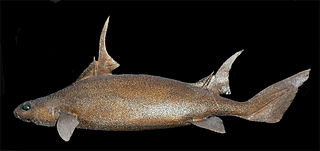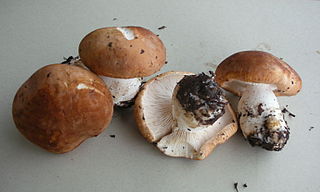
Rolf Singer was a German-born mycologist and one of the most important taxonomists of gilled mushrooms (agarics) in the 20th century.

The Lycée Louis-le-Grand, also referred to simply as Louis-le-Grand or by its acronym LLG, is a public Lycée located on rue Saint-Jacques in central Paris. It was founded in the early 1560s by the Jesuits as the Collège de Clermont, was renamed in 1682 after King Louis XIV, and has remained at the apex of France's secondary education system despite its disruption in 1762 following the suppression of the Society of Jesus. It offers both a high school curriculum, and a Classes Préparatoires post-secondary-level curriculum in the sciences, business and humanities.

Pallas's sandgrouse is a medium to large bird in the sandgrouse family.

Dilong is a genus of basal tyrannosauroid dinosaur. The only species in this genus is Dilong paradoxus. It is from the Lower Cretaceous Yixian Formation near Lujiatun, Beipiao, in the western Liaoning province of China. It lived about 126 million years ago. This theropod discovery was significant as it was one of the first tyrannosauroids with fossil evidence of simple feathers.

The Hispaniolan solenodon, also known as the agouta, is a small, furry, shrew-like mammal endemic to the Caribbean island of Hispaniola. Like other solenodons, it is a venomous, insect-eating animal that lives in burrows and is active at night. It is an elusive animal and was only first described in 1833; its numbers are stable in protected forests but it remains the focus of conservation efforts.

The sailfin roughshark is a species of dogfish shark in the family Oxynotidae, found in the eastern North Atlantic from Scotland to Senegal between latitudes 61°N and 11°N, at depths of between 265 and 720 m. Its length is up to 1.2 m (3.9 ft).

Leucopaxillus is a genus of fairly large white-spored gilled mushrooms which are found worldwide growing on the ground in woodlands. These are saprotrophs, but may sometimes be ectomycorrhizal. Less than ten species of Leucopaxillus are known to grow in North America. No species of Leucopaxillus are known to be poisonous, but they do not have an appealing taste or texture. The widespread genus contains about 15 species.

Clitocybe nebularis or Lepista nebularis, commonly known as the clouded agaric, cloudy clitocybe, or cloud funnel, is an abundant gilled fungus which appears both in conifer-dominated forests and broad-leaved woodland in Europe and North America. Appearing in Britain from mid to late autumn, it is edible, but may cause gastrointestinal issues.
The Nicaraguan harvest mouse is a species of rodent in the family Cricetidae. It is found in Costa Rica and Nicaragua.

The five-toed pygmy jerboa is a species of rodent in the family Dipodidae. It is monotypic within the genus Cardiocranius. It is found in China, Kazakhstan, and Mongolia.
Marcano's solenodon is an extinct species of mammal in the family Solenodontidae known only from skeletal remains found on the island of Hispaniola.
The paradox vole is a species of rodent in the family Cricetidae found in southern Turkmenistan.

Leucopaxillus gentianeus is a bitter-tasting, inedible mushroom commonly known as the bitter false funnelcap, or the bitter brown leucopaxillus. A common synonym is Leucopaxillus amarus. The bitter taste is caused by a triterpene called cucurbitacin B. The species was first described in 1873 as Clitocybe gentianea by French mycologist Lucien Quélet. František Kotlaba transferred it to Leucopaxillus in 1966.

Aspropaxillus giganteus, also Leucopaxillus giganteus, commonly known as the giant leucopax or the giant funnel, is a saprobic species of fungus in the order Agaricales. As its common names imply, the fruit body, or mushroom, can become quite large—the cap reaches diameters of up to 50 cm (20 in). It has a white or pale cream cap, and is funnel-shaped when mature, with the gills running down the length of the stem. Considered by some to be a choice edible when young, this species has a cosmopolitan distribution, and is typically found growing in groups or rings in grassy pastures, roadside hedges, or woodland clearings. It has been shown to contain a bioactive compound with antibiotic properties.

Leucopaxillus albissimus, commonly known as the large white leucopaxillus, is a species of mushroom that lives as a saprobe, decaying the litter under coniferous trees. It produces a large white fruiting body that is unusually resistant to decay. It is considered to be inedible.

Louise (Bourgeois) Boursier (1563–1636) was a French Royal Court midwife who delivered babies for many women in her twenty-six year professional career. Marie de Médicis, the wife of Henry the Great of France, was one of her patients, and Bourgeois delivered her six children. Bourgeois' income was about ten times the average midwife's. She believed she was blessed with practical midwifery talents from Phaenarete, the mother of Socrates.

Cardiocraniinae is a subfamily of rodents in the family Dipodidae, named by the Russian zoologist Boris Stepanovich Vinogradov (1891–1958) in 1925. These jumping rodents are small mammals, less than 20 cm long.
Events from the year 1636 in France
Paradoxus is a genus of moths of the family Yponomeutidae.












